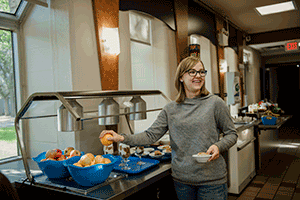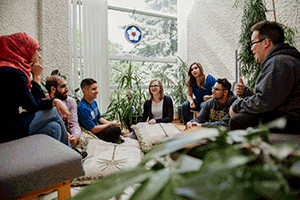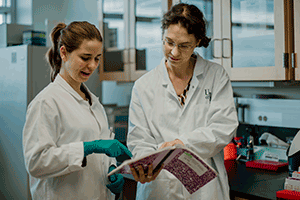Ready to learn more?
Get all the details straight to your inbox!

Living in The Student Village at Luther College, our student residence, comes with a choice of healthy, nutritious meal plans. That means no grocery shopping, no meals to cook, and no dirty dishes to worry about. You can focus on your studies and wellness!

Luther College students are eligible for nearly $100,000 in academic awards – in addition to scholarships and bursaries awarded by the U of R.

Luther College is recognized for its high standards of teaching, focused research, and one-on-one academic advising. We value and protect this heritage of excellence in scholarship, freedom of inquiry, and faithful seeking after truth.

Luther College is a great choice for high school to university transition. Enjoy all the benefits of a larger campus, without feeling lost in the crowd. Our community is full of caring mentors and peers to ensure a positive student experience.

Luther College appeals to students who want to study in a safe, nurturing, and inclusive environment. We welcome students of all faiths, ethnicities, backgrounds, religions, genders, and sexual orientations.

Wondering where to live? Our student residence, The Student Village at Luther College, is considered a great choice for first-year student accommodation. Individual private rooms mean you can stick to your own schedule and you never have to deal with roommate hassles.

Luther students can register in Arts, Science, or Media, Art, and Performance. Luther students are U of R students and receive a U of R degree.

Luther College offers Bundles programs that group together first-year students and classes to give you a great start and help ease the transition from high school to university.
Get all the details straight to your inbox!

Dr. Nicole Hansmeier is an Associate Professor in Biology at Luther College at the University of Regina. The main themes of her research include the study of the molecular basis of infectious diseases, improve disease tracking within communities and identification of biomarkers which can be used to diagnose adverse health events.
One major goal of her research is to gain a better understanding of how pathogens colonize and invade their hosts and ultimately cause disease. To this end, her research applies systems biological multi-Omics and high-end imaging techniques to identify host-pathogen interactions and disease pathways. She also leads a program using wastewater-based surveillance to detect and monitor infectious diseases (in the province) to inform public health responses.
Her research is supported by the Canadian Foundation for Innovation, Innovation Saskatchewan, Health Canada, SHRF, Natural Sciences and Engineering Research Council and Mitacs.
BIOL 100 – Biology I
BIOL 150 – Biological Principles
BIOL 222SCBC/ScN – Microbiology for Health Professionals
BIOL 224 – Introduction to Medical Microbiology
BIOL 303 – Medical Microbiology
BIOL 396 – Independent Research in Biology
BIOL 880AQ– Special topic course
BIOL 901– Research course
https://scholar.google.com/citations?hl=en&user=3mlsEA4AAAAJ
*Denotes corresponding authorship; $indicates student contributions
Felipe-Lopez A., Hansmeier N., Danzer C., Hensel M. (2023). Manipulation of microvillar proteins during Salmonella enterica invasion results in brush border effacement and actin remodeling. Frontiers in Cellular and Infection Microbiology 13: DOI: 10.3389/fcimb.2023.1137062
Hansmeier N., Sharma S. $, Chao T.C. * (2022). Protein purification and digestion methods for bacterial proteomic analyses. Methods in Molecular Biology: Proteomics in Systems Biology (book series by Springer Nature) 2456: pp. 63-70. (Invited submission, Book Chapter) https://doi.org/10.1007/978-1-0716-2124-0_5
Chao T.C., Thapa S. $, Hansmeier N. * (2022). Affinity-enrichment of Salmonella-modified membranes from murine macrophages for proteomic analyses. Methods in Molecular Biology: Proteomics in Systems Biology (book series by Springer Nature) 2456: pp. 263-273. (Invited submission, Book Chapter) https://doi.org/10.1007/978-1-0716-2124-0_18
Barrila J., Sarker S.F., Hansmeier N., Yang S. et al. (2021). Evaluating the effect of spaceflight on the host-pathogen interaction between human intestinal epithelial cells and Salmonella Typhimurium. Nature Partner Journals Microgravity 7:9. https://doi.org/10.1038/s41526-021-00136-w
Reuter T., Vorwerk S., Liss V., Chao T.C., Hensel M., Hansmeier N. * (2020). Proteomic analysis of Salmonella-modified membranes reveals adaptations to macrophage hosts. Molecular and Cellular Proteomics 19(5):900-912.https://doi.org/10.1074/mcp.RA119.001841
Noster J., Hansmeier N., Persicke M., Chao T.C, Kurre R., Popp J., Liss V., Reuter T., Hensel M. * (2019).Blocks in tricarboxylic acid cycle of Salmonella enterica cause global perturbation of carbon storage, motility and host-pathogen-interaction.mSpere 4(6):e00796-19. https://doi.org/10.1128/mSphere.00796-19
Noster J., Persicke M., Chao T.C., Krone L., Hensel M. *, Hansmeier N. * (2019) Impact of ROS-induced damage of TCA cycle enzymes on metabolism and virulence of Salmonella enterica serovar Typhimurium. Frontiers in Microbiology 10, 762. https://doi.org/10.3389/fmicb.2019.00762
Noster J., Chao T.C, Sander N., Schulte M., Reuter T., Hansmeier N. *, Hensel M. * (2019). Proteomics of intracellular Salmonella enterica reveals roles of Salmonellapathogenicity island 2 in metabolism and antioxidant defense” PLOS Pathogen15(4): e1007741. https://doi.org/10.1371/journal.ppat.1007741
Schulte M., Sterzenbach T., Miskiewicz K., Elpers L., Hensel M. *, Hansmeier N. * (2019). A versatile remote control system for functional expression of bacterial virulence genes based on the tetA promoter. International Journal of Medical Microbiology 3309 (1), 54-65. https://doi.org/10.1016/j.ijmm.2018.11.001
Hansmeier N., Buttigieg J., Pelle S., Choi K.Y., Kopriva D. and Chao T.C. (2018). Identification of mature atherosclerotic plaque proteome signatures using Data-Independent Acquisition Mass Spectrometry. Journal of Proteome Research 17 (1), 164-76. https://doi.org/10.1021/acs.jproteome.7b00487
Hansmeier N., Miskiewicz K., Elpers L., Liss V., Hensel M., Sterzenbach T. (2017). Functional expression of the entire adhesiome of Salmonella enterica serotype Typhimurium. Scientific Reports 4;7(1):10326. https://dx.doi.org/10.1038%2Fs41598-017-10598-2
Vorwerk S., Krieger V., Deiwick J., Hensel M andHansmeier N.* (2015). Proteomes of host cells membranes modified by intracellular activities of Salmonella enterica. Molecular and Cellular Proteomics 14, 81-92. https://dx.doi.org/10.1074%2Fmcp.M114.041145
Hansmeier N.*, Chao T.-C., Herbstman J. B., Goldman L.R., Witter F.R., Halden R.U.* (2015). Elucidating the molecular basis of adverse health effects from exposure to anthropogenic polyfluorinated compounds using toxicoproteomic approaches. Journal of Proteome Research14, 51-58. https://doi.org/10.1021/pr500990w
Herwig J.-A., Hansmeier N., Otto A., Geffken A., Subbarayal P., Prusty B.K., Becher D., Hensel M., Schaible U.E., Rudel T., Hilbi H. (2015). Purification and proteomics of pathogen-modified vacuoles and membranes. Frontiers in Cellular and Infection Microbiology5, 48. https://doi.org/10.3389/fcimb.2015.00048
Keller R., Ariöz, C., Hansmeier N., Stenberg-Bruzell F., Burstedt M., Vikström D., Kelly A., Wieslander A., Daley D., Hunke S. (2015). The Escherichia coli envelope stress sensor CpxA responds to changes in lipid bilayer properties. Biochemistry, 16;54(23):3670-6. https://doi.org/10.1021/acs.biochem.5b00242
Lorkowski M., Felipe-Lopez A., Danzer C., Hansmeier N., Hensel M. (2014). Salmonella enterica invasion of polarized epithelial cells is a highly cooperative effort. Infection and Immunity82, 2657-2667. https://doi.org/10.1128/IAI.00023-14
Chao T.-C. & Hansmeier N.* (2013). Microfluidic devices for high-throughput proteome analysis. Proteomics13, 467-479. (Invited review) https://doi.org/10.1002/pmic.201200411
Noster J., Popp J., Hansmeier N., Persicke M., Kurre R., Richter C.R., Krieger V., Vorwerk S., Hensel M. (2013). Defects in the TCA cycle result in increased phagocytic uptake of Salmonella enterica. International Journal of medical microbiology - Proceedings of the 65th Jahrestagung der Deutschen Gesellschaft für Hygiene und Mikrobiologie - 303, 49-49.
Hansmeier N., Chao T.-C., Goldman L.R., Witter F.R., Halden R.U. (2012). Prioritization of biomarker targets in human umbilical cord blood: identification of proteins in infant blood serving as validated biomarkers in adults. Environmental Health Perspectives 120, 764-769. https://doi.org/10.1289/ehp.1104190
Barlag B., Beutel O., Janning D., Hansmeier N., Piehler J., Hensel M. (2012). Cooperation of two protein secretion systems during the interaction of Salmonella enterica with host cells. International Journal of medical microbiology - Proceedings of the 64th Jahrestagung der Deutschen Gesellschaft für Hygiene und Mikrobiologie 302, 70-70.
Vorwerk S., Deiwick J., Hansmeier N., Hensel M. (2012). Proteomic analysis of Salmonella-modified membranes. International Journal of medical microbiology - Proceedings of the 64th Jahrestagung der Deutschen Gesellschaft für Hygiene und Mikrobiologie - 302, 67-67.
Chao T.-C. & Hansmeier N.* (2012). Current state of microbial proteomics: Where we are and where we want to go. Proteomics12 638-650. (Invited review) https://doi.org/10.1002/pmic.201100381
Chao T.-C., Song G., Hansmeier N., Westerhoff P., Herckes P., Halden, R.U. (2011). Characterization and LC-MS/MS based quantification of hydroxylated fullerenes. Analytical Chemistry83, 1777-1783. https://doi.org/10.1021/ac1031379
Chao T.-C., Hansmeier N., Halden, R.U. (2010). Towards proteome standards: The use of absolute quantitation in high-throughput biomarker discovery. Journal of Proteomics 73, 1641-1646. https://doi.org/10.1016/j.jprot.2010.04.004
Chao T.-C., Kalinowski J., Nyalwidhe J., Hansmeier N.* (2010a). Comprehensive proteome profiling of the Fe(III)-reducing myxobacterium Anaeromyxobacter dehalogenans 2CP-C during growth with fumarate and ferric citrate. Proteomics 10, 1673-1684. https://doi.org/10.1002/pmic.200900687
Ros R. & Hansmeier N. (2009). Gene classification and quantitative analysis of gene regulation in bacteria using single cell atomic force microscopy and single molecule force spectroscopy in Single cell analysis, Wiley-VCH 19-37. https://doi.org/10.1002/9783527626649.ch2
Jochmann N., Kurze A.-K., Czaja L. F., Brinkrolf K., Brune I., Hüser A. T., Hansmeier N., Pühler A., Borovok I., Tauch A. (2009). Genetic makeup of the Corynebacterium glutamicum LexA regulon deduced from the comparative transcriptomics and in vitro DNA band shift assays. Microbiology 155, 1459-1477. https://doi.org/10.1099/mic.0.025841-0
Jungwirth B., Emer D., Brune I., Hansmeier N., Pühler A., Eikmanns B. J., Tauch A. (2008). Triple transcriptional control of the resuscitation promoting factor 2 (rpf2) gene of Corynebacterium glutamicum by the regulators of acetate metabolism RamA and RamB and the cAMP-dependent regulator GlxR. FEMS Microbiology Letters 281, 190-197. https://doi.org/10.1111/j.1574-6968.2008.01098.x
Hansmeier N., Chao T.-C., Daschkey S., Müsken M., Kalinowski J., Pühler A., Tauch A. (2007). A comprehensive proteome map of the lipid-requiring nosocomial pathogen Corynebacterium jeikeiumK411. Proteomics 7, 1076-1096. https://doi.org/10.1002/pmic.200600833
Anselmetti D., Hansmeier N., Kalinowski J., Martini J., Merkle T., Palmisano R., Ros R., Schmied K., Sischka A., Toensing K. (2007). Analysis of subcellular surface structure, function and dynamics. Anal. Bioanal. Chem. 387, 83-89. https://doi.org/10.1007/s00216-006-0789-3
Hansmeier N., Albersmeier A., Tauch A., Damberg T., Ros R., Anselmetti D., Pühler A., Kalinowski J. (2006). The surface (S)-layer gene cspB of Corynebacterium glutamicum is transcriptionally activated by a LuxR-type regulator and located on a 6 kb genomic island absent from the type strain ATCC 13032. Microbiology 152, 923-935. https://doi.org/10.1099/mic.0.28673-0
Hansmeier N., Chao T.-C., Kalinowski J., Pühler A., Tauch A. (2006b). Mapping and comprehensive analysis of the extracellular and cell surface proteome of the human pathogen Corynebacterium diphtheriae. Proteomics 6, 2465-2476. https://doi.org/10.1002/pmic.200500360
Hansmeier N., Chao T.-C., Pühler A., Tauch A., Kalinowski J. (2006a). The cytosolic, cell surface and extracellular proteomes of the biotechnologically important soil bacterium Corynebacterium efficiens YS-314 in comparison to those of Corynebacterium glutamicumATCC 13032. Proteomics 6, 233-250. https://doi.org/10.1002/pmic.200500144
Chao T.-C., Buhrmester J., Hansmeier N., Pühler A., Weidner S. (2005). The role of the regulatory gene rirA for the transcriptional response of Sinorhizobium meliloti to iron limitation. Applied Environmental Microbiology 71, 5969-5982. https://doi.org/10.1128/aem.71.10.5969-5982.2005
Hansmeier N., Bartels F.W., Ros R., Anselmetti D., Tauch A., Pühler A., Kalinowski J. (2004). Classification of hyper-variable Corynebacterium glutamicum surface-layer proteins by sequence analyses and atomic force microscopy. Journal of Biotechnology112, 177-193. https://doi.org/10.1016/j.jbiotec.2004.03.020